

Grub's up: can insects feed the world? China deploys drones to spy on polluting industries. Aerial view of Beijing enveloped in thick smog.

Photograph: ImagineChina/Corbis China is using drones to spy on polluting industries in its attempts to battle the lung-choking smog that frequently engulfs many of its cities. The deputy minister of environmental protection, Zhai Qing said drones have recently been used in Beijing, Shanxi and Hebei provinces to inspect for pollution. These are some of the worst affected areas of China, with a high number of coal-fired power stations, steel mills and cement plants.
The unmanned aircraft can cover 70 sqkm during a two hour flight. Peak water, peak oil... Now, peak soil? (ScienceAlert) Soil provides nearly all of our food and it's becoming endangered.
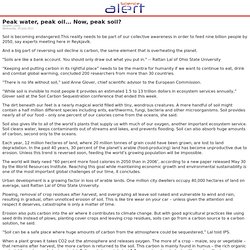
As planet heats up, fertile soil isn’t guaranteed. PURDUE (US) — A new study casts doubt on the assumption that warmer climates will speed the return of nitrogen to soils, making them more fertile for plants.

Increased temperatures from climate change have been expected to speed decomposition of plant materials and the return of nitrogen to soils. But Jeff Dukes, an associate professor of forestry and natural resources at Purdue University, found that the microbes responsible for returning nitrogen to soils react differently to a range of climate scenarios. “More nitrogen being available is not something we can count on in all ecosystems,” says Dukes, whose findings were published in the journal Global Change Biology. While warming has been expected to accelerate nitrogen cycling, the study’s results suggest it may actually have little to no effect on the process in some ecosystems. Dukes runs the Boston-Area Climate Experiment, which measures ecosystem responses to climate change. Source: Purdue University. The real threat to our future is peak water. Peak oil has generated headlines in recent years, but the real threat to our future is peak water.
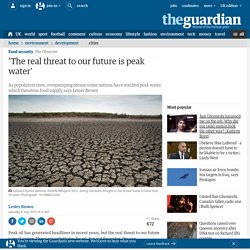
There are substitutes for oil, but not for water. We can produce food without oil, but not without water. We drink on average four litres of water per day, in one form or another, but the food we eat each day requires 2,000 litres of water to produce, or 500 times as much. Getting enough water to drink is relatively easy, but finding enough to produce the ever-growing quantities of grain the world consumes is another matter. Grain consumed directly supplies nearly half of our calories. Irrigation efficiency makes jump with iFarm app. NMSU civil engineering Professor Zohrab Samani and local farmer John Storm view data on iFarm, an online application developed by Samani to enable more efficient water usage on farms.

(NMSU photo by Isabel A. Rodriguez) Around 700 million people in 43 countries suffer from water scarcity today, according to the United Nations. Because of those alarming statistics, it’s now more important than ever that New Mexicans work to preserve the precious, irreplaceable resource. Zohrab Samani, civil engineering professor at New Mexico State University, is doing his part by developing a digital application that will help farmers determine when and how frequently they should irrigate their crops. Marine agriculture in water scarce regions. Costa Rican academics are pioneering the growth of crops on freshwater lakes as a way of addressing food shortages.

Hunger and nutrition will feature prominently at the G8 summit in Northern Ireland in June, in keeping with the renewed interest in agriculture, especially in Africa, where investors are eyeing the potential of vast tracts of land. But as experts note, water is the most severe impediment to increasing food production and security. Driverless Tractors Till High-Tech Farm. As the harvest nears, the employees of German farmer Klaus Muenchhoff are busy making the final checks on imposing tractors ready to roll into the golden fields.

But these tractors are steel monsters with a difference -- driverless and satellite-guided, they can operate on the fields with an accuracy of a few centimeters (inches). Impervious to fatigue and indifferent to poor visibility, they reduce distances traveled by each vehicle, saving their owner fuel costs and improving crop yields. VIDEO: Urban Farms Grow Up. Evolution of animal production in emerging markets: China, Russia, ... Water, energy, and food under climate extremes— Are water markets a solution? The theme of this year's World Water Day (March 22, 2014) is “Water and energy.”
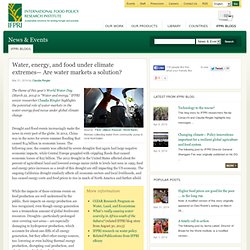
IFPRI senior researcher Claudia Ringler highlights the potential role of water markets in the water-energy-food nexus under global climate change Drought and flood events increasingly make the news in every part of the globe. In 2012, China was in the news for severe summer flooding that caused $14 billion in economic losses. The following year, the country was affected by severe droughts that again had large negative economic impacts, while Central Europe grappled with crippling floods that caused economic losses of $22 billion.
The 2012 drought in the United States affected about 80 percent of agricultural land and lowered average maize yields to levels last seen in 1995; food and energy price increases as a result of this drought are still impacting the US economy. Energy-Water Nexus Around the World and the Missing Link. Source: Chenected As we have highlighted before, Texas is experiencing significant population growth, adding around 1,000 people a week to the state, which increases the need for both water and electricity.
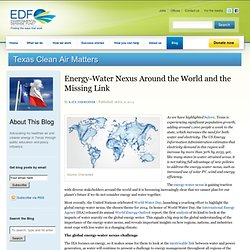
The US Energy Information Administration estimates that electricity demand in this region will increase by more than 30% by 2035, yet, like many states in water-strained areas, it is not taking full advantage of new policies to address the energy-water nexus, such as increased use of solar PV, wind and energy efficiency. The energy-water nexus is gaining traction with diverse stakeholders around the world and it is becoming increasingly clear that we cannot plan for our planet’s future if we do not consider energy and water together.
Most recently, the United Nations celebrated World Water Day, launching a yearlong effort to highlight the global energy-water nexus, the chosen theme for 2014. The global energy-water nexus challenge. Worldwatch Institute: global biofuel production fell in 2012 for first time since 2000. Worldwatch Institute: global biofuel production fell in 2012 for first time since 2000 In 2012, the combined global production of ethanol and biodiesel fell for the first time since 2000, down 0.4% from the figure in 2011, according to the Worldwatch Institute’s latest Vital Signs Online report.
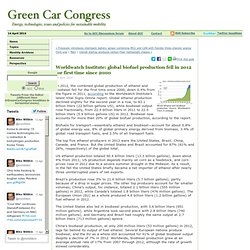
Global ethanol production declined slightly for the second year in a row, to 83.1 billion liters (22 billion gallons US), while biodiesel output rose fractionally, from 22.4 billion liters in 2011 to 22.5 billion liters (5.9 billion gallons US) in 2012. Biodiesel now accounts for more than 20% of global biofuel production, according to the report.
Livestock falling ill in fracking regions, raising concerns about food. While scientists have yet to isolate cause and effect, many suspect chemicals used in drilling and hydrofracking (or "fracking") operations are poisoning animals through the air, water, or soil. Last year, Michelle Bamberger, an Ithaca, New York, veterinarian, and Robert Oswald, a professor of molecular medicine at Cornell's College of Veterinary Medicine, published the first and only peer-reviewed report to suggest a link between fracking and illness in food animals.
The authors compiled 24 case studies of farmers in six shale-gas states whose livestock experienced neurological, reproductive, and acute gastrointestinal problems after being exposed—either accidentally or incidentally—to fracking chemicals in the water or air. The article, published in New Solutions: A Journal of Environmental and Occupational Health Policy, describes how scores of animals died over the course of several years. Continue reading at The Ecologist. Livestock image via Shutterstock. The Shocking Cost Of Food Waste. Food Waste Fuels Vertical Farming in Chicago. The Windy City is turning into a hotbed of sustainable urban agriculture. Entrepreneur John Edel is transforming The Plant, a 1920s era meatpacking facility in Chicago’s industrial Back of the Yards neighborhood (next to the Union Stockyards) into a net zero vertical farming operation fueled by food waste.
And a huge part of that transformation involves a giant anaerobic digester that converts food waste into biogas to power and heat the four-story, 93,500 square foot red brick warehouse. The conversion to a vertical farm and food business incubator was partly made possible thanks to a $1.5 million grant from the Illinois Department of Commerce and Economic Opportunity (DCEO) to support a comprehensive renewable energy system. Related: Queens University Students Turn an Abandoned Mill Into a Flourishing Urban Farm.
Climate and weather. Productivity. Biodiversity.